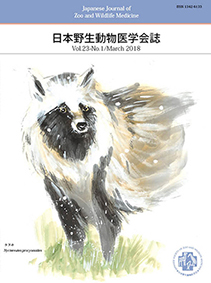
- Issue 4 Pages 83-
- Issue 3 Pages 51-
- Issue 2 Pages 27-
- Issue 1 Pages 1-
- |<
- <
- 1
- >
- >|
-
Nobuhide KIDO2018Volume 23Issue 1 Pages 1-6
Published: March 30, 2018
Released on J-STAGE: July 21, 2018
JOURNAL FREE ACCESSI have worked as a zoo veterinarian for 10 years. My work situation is not particularly intellectually stimulating, because the clinical cases and budget are limited. However, in spite of this situation, I could publish several manuscripts, which included clinical reports of case histories of zoo animals and research articles describing the wildlife rescue project. In addition, I could provide support to some keepers who were writing manuscripts. I focus on manuscripts for a particular reason. The work experience in the zoo is limited, and only a few previous reports have been published. Therefore, it is important to publish manuscripts and share information so as to help someone who is facing a similar problem and provide an opportunity to develop new knowledge. There are many challenges in the field of zoos and aquariums, and I think it is important for us to write about them and make them known. At this point, I believe I could make a contribution to develop the zoo and wildlife medicine. I will continue to make this effort in the future as well.
View full abstractDownload PDF (286K)
-
Keisuke KAWASE, Ran KIMURA, Shun-ichi SHIIHARA2018Volume 23Issue 1 Pages 7-14
Published: March 30, 2018
Released on J-STAGE: July 21, 2018
JOURNAL FREE ACCESSWe took regular blood samples from an Asian black bear, a giraffe, a tiger, lions, a savannah monkey and a mandrill following behavioral restraint using husbandry training and obtained hematological and biochemical values. We compared the values with previous reports. We concluded that blood collection following behavioral restraint using husbandry training was slightly less stressful, at least for the Asian black bear, giraffe and mandrill. This is the first report of blood test values obtained following behavioral restraint of the above-mentioned animals in Japan. We obtained individual reference values by regular blood collection and the values will aid in rearing management and health control.
View full abstractDownload PDF (373K)
-
Satomi SASANO, Atsuko KAWAI, Rikio WATANABE, Kenji ASA, Hironobu NISHI ...2018Volume 23Issue 1 Pages 15-18
Published: March 30, 2018
Released on J-STAGE: July 21, 2018
JOURNAL FREE ACCESSAn eight year old female Alpaca (Vicugna pacos) presented with posterior limb muscle atrophy and hoof ulcer. The animal was emaciated. No gastrointestinal symptoms were observed. Laboratory analysis results revealed hyperglycemia, hyperlipidemia, high amylase, anemia and ketonuria, leading to suspicion of diabetes mellitus. The animal died before initiation of insulin treatment. Postmortem exams revealed a reduction of pancreatic islet cells and artherosclerotic plaques, and diabetes mellitus was diagnosed. This is the first report of diabetes in Alpacas in Japan.
View full abstractDownload PDF (1972K) -
Eiko SHIMOKAWA, Hideyasu KANEMITSU, Kazunori KANDA, Masayuki AMANO, Hi ...2018Volume 23Issue 1 Pages 19-22
Published: March 30, 2018
Released on J-STAGE: July 21, 2018
JOURNAL FREE ACCESSAn American greater flamingo(Phoenicopterus ruber) chick that hatched in Kobe Municipal Oji Zoo presented with a walking difficulty, as it grew, because of a twisted knock-knee leg. To remedy this, we developed a double-joint device orthosis made from polypropylene and fixed it from the tibiotarsus to the tarsometatarsus region in the chick. The chick began to walk normally and responded to the effects of corrective treatment. However, we also made a number of improvements to the joint bending to this orthosis because of the formation of a superficial ulcer in the intertarsal joint of the chick, continuing corrective treatment for 254 days. Results confirm twisted leg symptom improvements following the removal of the orthosis, and the chick continued to live with the other flamingos.
View full abstractDownload PDF (1079K) -
Tomokazu KOZU, Shin-ichi NAKAMURA2018Volume 23Issue 1 Pages 23-26
Published: March 30, 2018
Released on J-STAGE: July 21, 2018
JOURNAL FREE ACCESSA Humboldt penguin that died of ascites was examined via pathological tests. Necropsy revealed the presence of numerous tumors around the ovary, and that these also spread to the mesentery and kidney. Based on the results of ascitic cytology, pathological examination of tissue, and immunostaining tests, a diagnosis of dysgerminoma occurring in the ovary was established. Characteristic tumor cells were observed in ascitic cytology, which suggest the possibility of antemortem diagnosis. There are very few reports on tumors in Humboldt penguins, and this is the first report of dysgerminoma in Humboldt penguins.
View full abstractDownload PDF (571K)
- |<
- <
- 1
- >
- >|